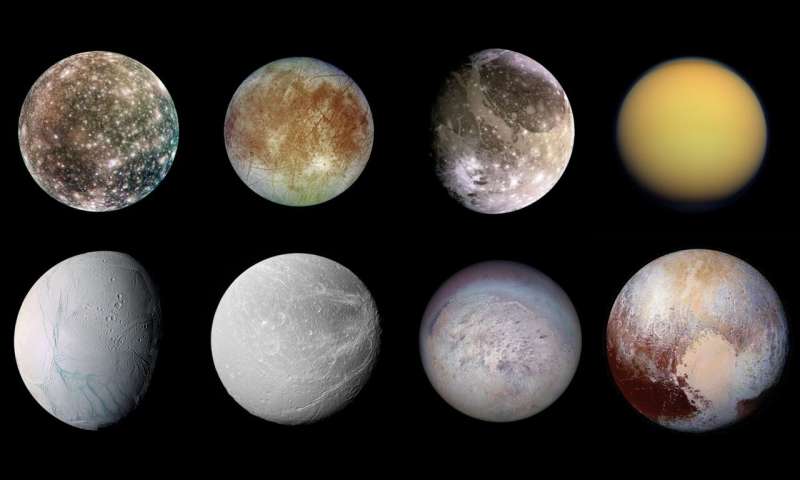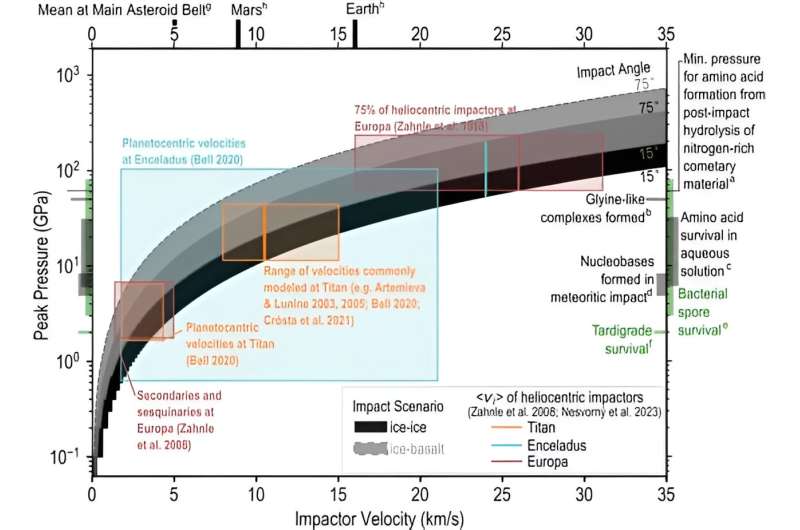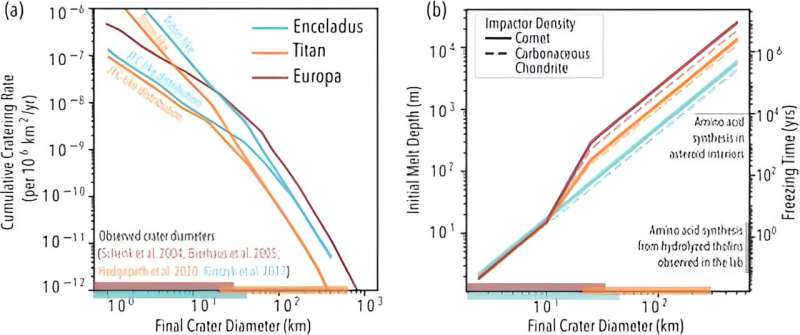This article has been reviewed according to Science X's editorial process and policies. Editors have highlighted the following attributes while ensuring the content's credibility:
fact-checked
peer-reviewed publication
trusted source
proofread
Could comets have delivered the building blocks of life to ocean worlds like Europa, Enceladus and Titan?

Throughout Earth's history, the planet's surface has been regularly impacted by comets, meteors, and the occasional large asteroid. While these events were often destructive, sometimes to the point of triggering a mass extinction, they may have also played an important role in the emergence of life on Earth. This is especially true of the Hadean Era (ca. 4.1 to 3.8 billion years ago) and the Late Heavy Bombardment, when Earth and other planets in the inner solar system were impacted by a disproportionately high number of asteroids and comets.
These impactors are thought to have been how water was delivered to the inner solar system and possibly the building blocks of life. But what of the many icy bodies in the outer solar system, the natural satellites that orbit gas giants and have liquid water oceans in their interiors (i.e., Europa, Enceladus, Titan, and others)?
According to a recent study led by researchers from Johns Hopkins University, impact events on these "ocean worlds" could have significantly contributed to surface and subsurface chemistry that could have led to the emergence of life.
The team was led by Shannon M. MacKenzie, a planetary scientist, and her colleagues at Johns Hopkins University Applied Physics Laboratory (JHUAPL). They were joined by researchers from Dartmouth's Thayer School of Engineering, the University of Western Ontario, Curtin University's School of Earth and Planetary Sciences, the Planetary Habitability Laboratory (PHL) at UPR at Arecibo, Jacobs Technology, NASA's Jet Propulsion Laboratory, and the Astromaterials Research and Exploration Science (ARES) at NASA Johnson Space Center.
The paper that details their findings was recently published in The Planetary Science Journal.
Exogenesis
As indicated in their paper, impacts from asteroids, comets, and large meteors are more often associated with destruction and extinction-level events. However, multiple lines of evidence indicate that these same types of impacts may have supported the emergence of life on Earth roughly 4 billion years ago.
These events not only delivered volatiles (such as water, ammonia, and methane) and organic molecules, but modern research indicates that they also created new substrates and compounds essential to life.
Moreover, they created a variety of environments that were essential to the emergence and sustainment of life on Earth. As the researchers wrote:
"Exogenously delivered materials have been estimated to be an important source of organics on early Earth. Shockwaves could provide the energy for organic synthesis of important precursors like HCN or amino acids.
"The iron and heat from very large impactors can facilitate the reducing atmospheric conditions necessary for abundant HCN production. Impacts fracture and, in typical terrestrial events, melt the target: the more permeable substrates and excavation of deeper rock layers promote hydrothermal activity and endolithic habitats."
According to the latest fossilized evidence, the earliest life forms emerged on Earth roughly 4.28 billion years ago. These fossils were recovered from hydrothermal vent precipitates in the Nuvvuagittuq Greenstone Belt in northern Quebec, Canada, confirming that hydrothermal activity played a vital role in the emergence of life on Earth.
But what about the many "ocean worlds" that reside in the outer solar system? This includes bodies like Europa, Ganymede, Enceladus, and Titan, as well as Uranus' moons Ariel and Titania, Neptune's moon Triton, and trans-Neptunian bodies like Pluto, Charon, and possibly more.

Ocean worlds
This term refers to bodies predominantly composed of volatile elements such as water and differentiated between an icy crust and a rocky and metallic core. At the core-mantle boundary, tidal flexing (the result of gravitational interaction with another body) causes a buildup of heat and energy released via hydrothermal vents into the ice.
This allows these worlds to maintain oceans of liquid water in their interiors. In short, these worlds have all the necessary ingredients for life: water, the requisite chemical compounds, and energy.
Furthermore, data from the NASA/ESA Cassini–Huygens mission confirmed that the plumes regularly erupting from Enceladus' southern polar region contain organic molecules. Last but not least, the presence of surface craters indicates that these bodies have experienced surface impacts throughout their history.
The question naturally arises: Could impacts have delivered the necessary building blocks of life to "ocean worlds" the same way they delivered them to the inner solar system? And if so, what does that mean about their potential habitability today? As the team wrote in their paper:
"Impact processes are likely an important part of the answers to these questions, as impacts can drive exchange through the ice crust—either through direct seeding or flushing through the crust—and therefore drive episodic influxes of organic and inorganic materials from the surface and/or from the impactor itself. Impacts can also generate ephemeral microcosms: any liquid water melted during impact freezes out over timescales commensurate with the impact energy."
"The exciting potential for chemistry within these pockets has been established, from concentrating salts to driving amino acid synthesis. Furthermore, shock-driven chemistry of icy, sometimes organic-rich (in the case of Titan especially) target materials may generate new 'seed' compounds (e.g., amino acids or nucleotides) in the melt pool."
Investigation
The first step for MacKenzie and her team was to investigate the initial shock levels created by the most common impacts for ocean worlds—comets that likely originated from the Kuiper Belt and Oort Cloud. To do this, the team calculated the velocities and maximum pressure that would be achieved by impacts involving icy and rocky bodies.
They also considered how this would vary based on different families (primary or secondary impacts) and which systems were involved—i.e., Jupiter or Saturn. Whereas primary impacts involve comets or asteroids, secondary impacts are caused by the ejecta they create.
In the case of the Jupiter and Saturn systems, secondary impactors may be icy or rocky depending on where they originated (an icy body like Europa, Enceladus, and Titan, a rocky body like Io and larger asteroids). Whereas primary impacts have higher velocities and produce larger melt volumes), secondary impacts are more frequent.
To determine melt sizes, the team consulted observed crater sizes on Europa, Enceladus, and Titan, and dynamic models that calculate the cumulative rate of cratering over time. They then compared the peak pressures at impact to thresholds for the survivability of elements essential to life, organic molecules, amino acids, and even microbes identified in previous studies.

From this, they determined that most impacts on Europa and Enceladus experience peak pressures greater than what bacterial spores can survive. However, they also determined that a significant amount of material still survives these impacts and that higher first-contact pressures could also facilitate the synthesis of organic compounds in the meltwater that fills the craters.
Meanwhile, on average, Titan and Enceladus experienced impacts with lower impact velocities, creating peak pressures that fall within the tolerance range for both bacterial spores and amino acids.
The next step was to consider how long fresh craters would survive and whether this would be sufficient for synthesizing biological materials. Based on the observed crater sizes on Enceladus and Europa, they determined that the longest-lived craters last only a few hundred years, whereas Titan could take centuries to tens of thousands of years for fresh craters to freeze.
While Europa and Enceladus experience more high-velocity impacts (due to Titan's dense atmosphere), the long-lived nature of Titan's craters means that all three bodies have a chance for organic chemistry experiments to occur.
They also considered resurfacing rates on Europa, Enceladus, and Titan and how these would cycle biological material to their interiors. In all three cases, the satellites have relatively "young" terrain, implying regular resurfacing events.
Results
Based on these considerations, Mackenzie and her team determined that melts produced by comet impacts on Europa, Enceladus, and Titan have been frequent and long-lived enough to be of astrobiological interest. However, this varies based on the composition of the comets and the surface ice in question. As they summarized:
"At Europa and Enceladus, the survival and deposition of impactor organics is more important as there are fewer surface organics within the ice crust to seed the melt pool. On Titan, the survival of elements like phosphorous may be more important.
"Thus, even the small, more frequent impact events contribute to the astrobiological potential by delivering less modified compounds to the surface that are available either for immediate reaction if melt is produced or for future processing (including in subsequent impact events)."
For instance, they found that a comet impacting Europa at the average impact velocity would create a 15 km (9.3 mi) crater and provide ~1 km3 (0.24 mi3) of meltwater.
Based on the abundance of glycine (an essential amino acid) found on the comet 67P Churyumov–Gerasimenko, they determined that several parts per million would survive—roughly three orders of magnitude higher than what has been observed forming around hydrothermal vents here on Earth.
"Thus, impactors seed whatever chemistry happens in the melt, providing organic and other essential elements depending on the impactor composition," they added.
While this does not necessarily mean that these and other "ocean worlds" are currently habitable or actively support life, they demonstrate potential for future study.
In the coming years, missions like the ESA's JUpiter ICy moons Explorer (JUICE), and NASA's Europa Clipper and Dragonfly missions will reach Ganymede, Europa, and Titan (respectively). There are also plans to create an Enceladus Orbiter to pick up where the Cassini-Huygens probe left off by examining Enceladus' plume activity more closely.
Therefore, conducting in-situ sampling and analysis on these moons could provide powerful insight into prebiotic chemical pathways and determine under what conditions life can emerge. These sample studies will also address the larger question of whether or not life could exist in the interiors of "ocean worlds," providing a preview of what future missions prepared to explore beneath the ice will find.
More information: Shannon M. MacKenzie et al, Impacts on Ocean Worlds Are Sufficiently Frequent and Energetic to Be of Astrobiological Importance, The Planetary Science Journal (2024). DOI: 10.3847/PSJ/ad656b
Journal information: The Planetary Science Journal
Provided by Universe Today




















